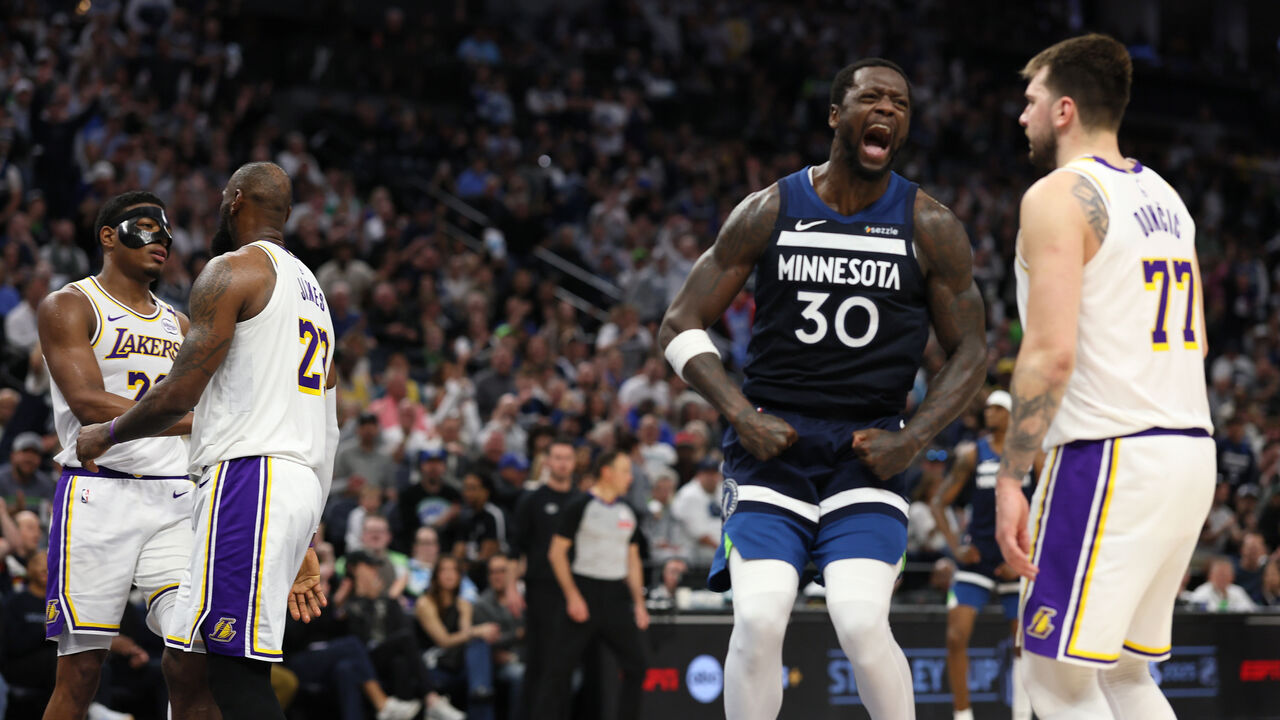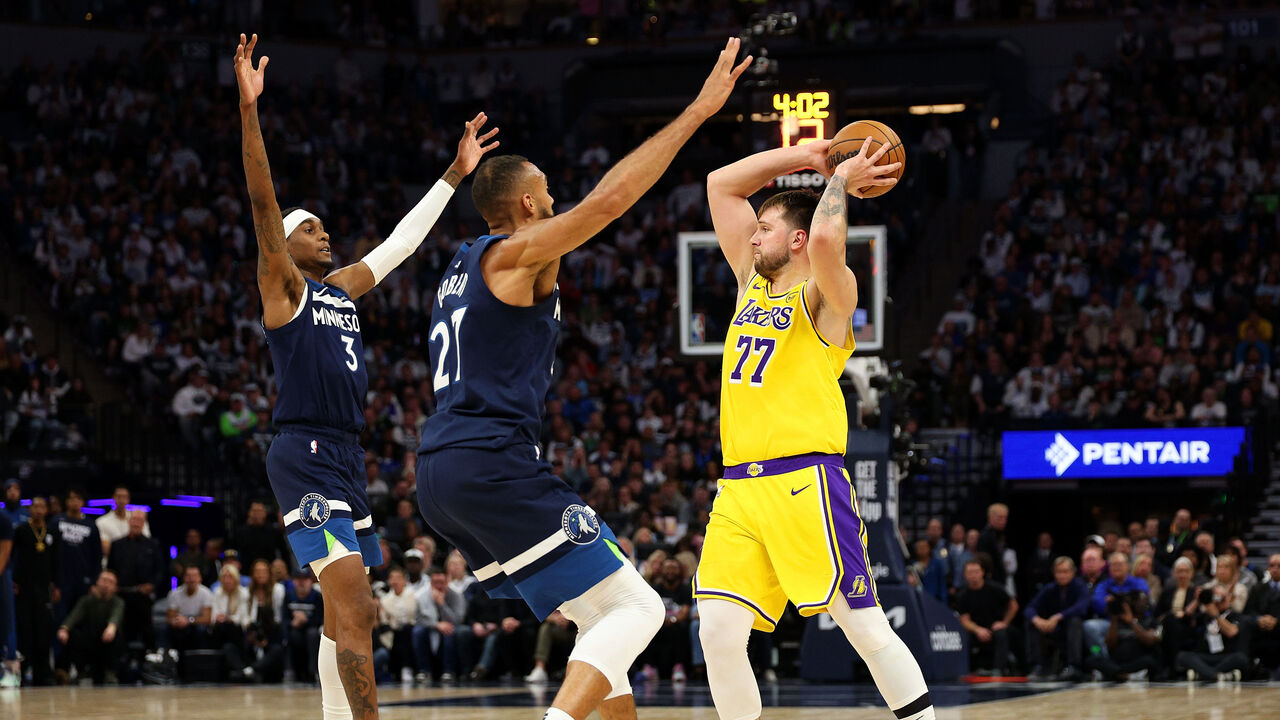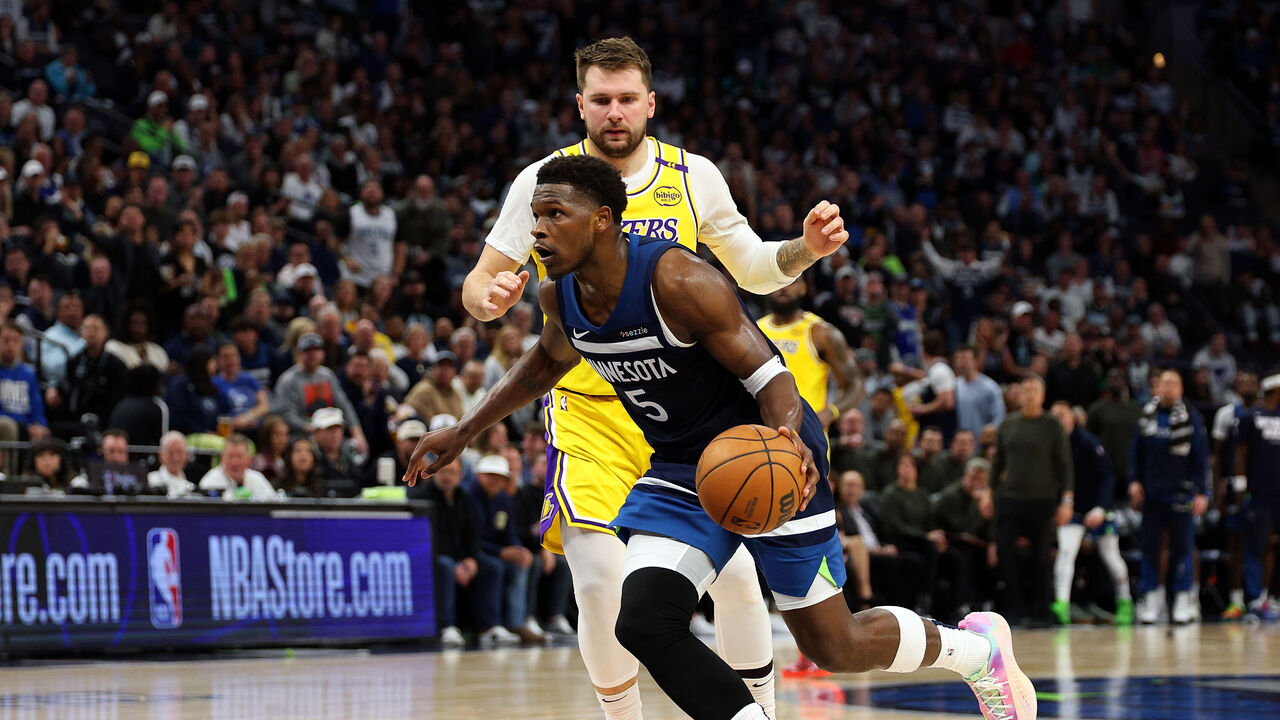How a stylistic tug-of-war is dictating Wolves-Lakers
They say styles make fights, and that's rarely more evident than it is during playoff basketball. For proof, look no further than the thrilling first-round series between the Minnesota Timberwolves and Los Angeles Lakers, which the T-Wolves lead 3-1 after a nail-biting Game 4 win.
Countless plot points have emerged in the series - Anthony Edwards' latest superstar turn, Julius Randle's redemption arc, the heroic shotmaking of Naz Reid and Jaden McDaniels, LeBron James still playing elite back-line defense at age 40, JJ Redick shrinking his rotation to an extent that would make Tom Thibodeau envious - but almost all of those developments tie back to the stylistic clash at the heart of this matchup: the very different ways the two teams are constructed, and the ways their respective constructions are forcing or allowing them to play at either end of the floor.
The differences mainly come down to size, depth, defensive acumen, and, by extension, lineup and schematic flexibility - distinctions that basically all favor Minnesota. The hope for L.A. coming into the series was that the combined scoring and shot-creating prowess of James, Luka Doncic, and Austin Reaves would be enough to overcome any inherent matchup disadvantages. That hope wasn't unfounded; the Lakers entered the fourth quarter of Game 4 with a 10-point lead, 12 minutes away from reclaiming home-court advantage in what would've become a best-of-three.
Instead, they'll have to win three straight elimination games against a hungry and dialed-in opponent. But the T-Wolves certainly aren't out of the woods yet, and you can never count out a team with James and Doncic at the reins. So, let's look at how the series ended up here and what the Lakers are up against as they look to claw their way back.

Before the playoffs, I wondered which style would win out when a T-Wolves team that likes to play multiple bigs went up against a Lakers team that frequently plays none. I also wondered how short a leash Minnesota would have on its biggest player, Rudy Gobert, if this matchup proved challenging for him. We've gotten some interesting answers to those questions.
The Lakers, for their part, decided very early on that they couldn't trust their lone big man in Jaxson Hayes. They've played him 31 total minutes across the first four games of the series and have been outscored by 17 points in those minutes. They've been center-less the rest of the time, with James and/or Dorian Finney-Smith serving as their nominal five.
In spite of that, the T-Wolves are shooting just 53.6% inside the restricted area, which ranks dead last among all playoff teams. That's a credit to the work James has done as a sweeper on the back line. He's held Minnesota to 36.4% at the rim when he's in the vicinity, second to only Draymond Green among players contesting at least five rim shots per game in the playoffs, per NBA Advanced Stats.
It's really been a full team effort, though. Ever since trading Anthony Davis for Doncic, the Lakers have had to rely on rim protection by committee, making up for their lack of one true anchor with the sheer volume of bodies they jam onto the strong side of the floor. They switch almost every screen, aiming to flatten out opposing offenses and willing to live with a bad matchup as long as they have layers of help waiting behind it. While that's worked well to limit the damage at the rim in this series, it's also led to them conceding a lot of clean catch-and-shoot threes, with Minnesota canning 45.8% of them.
The Timberwolves also have a 35% offensive rebound rate, and they're winning the overall possession battle by about five shooting possessions per game. And it's not like they're just doing that with their jumbo frontcourts; Gobert's averaging only 26 minutes because of his complete inability to utilize his height advantage at the offensive end. The bigger story is that Minnesota's been much better than L.A. at playing small. The Randle-Reid frontcourt has outscored the Lakers by 14.6 points per 100 possessions across 70 minutes, per PBP Stats.
The T-Wolves' defense has allowed about three fewer points per 100 possessions with Gobert on the floor, but their offense has scored about nine fewer points per 100 with him out there. They've still won his minutes because of how stout he's been on the glass and in ball-screen coverage, which really speaks to the options coach Chris Finch has at his disposal. Where Finch can mix and match personnel and scheme as the situation dictates, the Lakers don't have much choice but to play the way they're playing. (Though Redick surely could've found a couple minutes to squeeze in a sixth or seventh man in the second half of Game 4.)

All of which brings us to Edwards and Doncic. There's been a lot of talk about how the two No. 1 options have performed relative to one another, a particularly juicy storyline given that Doncic's Mavericks eliminated Edwards and the T-Wolves in last year's West finals. One thing that really stands out is that Edwards is averaging more assists than Doncic despite the latter being a vastly superior passer. And that can't only be chalked up to Edwards' teammates making more shots.
For one thing, he's delivered more assists to the rim than Doncic has. For another, the two are virtually even in potential assists, with Doncic holding a tiny 10.5 to 10.3 edge, per NBA Advanced Stats. (Doncic averaged 13.4 during the regular season, compared to Edwards' 8.4.) Tack on the fact that Edwards has just six turnovers in the series while Doncic has 18, and it's hard to dispute the fact that Edwards has been the more effective playmaker.
Of course, nothing on an NBA court happens in a vacuum, and you can't separate those numbers from the type of defense each player is facing. Edwards, for example, is starting games with Reaves as his primary defender, while Doncic has to deal with the octopus-armed McDaniels. Knowing the Lakers are switching everything, Edwards can basically pick out any matchup he wants, with better options to choose from than Doncic has. He's been particularly cruel to Doncic himself, torching him for 39 points on 15-for-25 shooting with six assists and zero turnovers, according to NBA.com's matchup data.
So, while Edwards' poise as a decision-maker in this series is a monumental development, the real separator in a star-versus-star comparison would be that he's been a major component of his team's ironclad defensive unit, while Doncic has been a weak link who's been targeted and exploited.
Because the Lakers are less concerned with who's guarding the ball than with who's helping in the gaps away from it, they've been too content to concede switches with Doncic and Rui Hachimura. It's either leading to high-value shots for Edwards or prompting overloads that lead to skip passes, kickouts, or lay-downs to guys like McDaniels, Reid, and Randle. Those guys are shooting a combined 12-for-25 from deep off of Edwards' passes. (Randle is also taking major advantage of L.A.'s switch-happy tendencies.)

Edwards is playing smart, patient, and ruthlessly opportunistic basketball - sometimes attacking right away, sometimes probing with a live dribble or stringing out a double-team until a seam opens up. He isn't settling, but he isn't forcing anything either. His rim frequency is up from 26% in the regular season to 33% in this series, which is particularly impressive considering league-wide rim volume plummets in the postseason.
He's shooting only 50% when he gets there because of all the traffic the Lakers are putting in front of the basket, but repeatedly collapsing the defense is still hugely benefiting Minnesota's offense, especially given the way he's passing the ball. His drives are up from 13.2 to 16.8 per game, and he's more than doubled his average number of assists out of those drives, from 1.1 to a league-leading 2.3. After running a negative assist-to-turnover ratio on drives during the regular season, he has a 3-to-1 ratio against the Lakers.
The T-Wolves have the luxury of being more conservative in their coverages against Doncic, both because they have better individual rim protection and because they can trust most of their defenders to handle that matchup with minimal help. Also, contrary to the Lakers' soft-switching approach, McDaniels has fought pretty hard to get around screens and maintain his Doncic assignment.
While they've mixed things up a lot, the Timberwolves have largely tried to play Doncic's pick-and-rolls two-on-two and his isolations straight up, even when that means leaving Gobert or Reid on an island. (Reid's been passable in those situations, while Gobert's been genuinely good.) They've essentially invited him to be a scorer, and, the generational scorer that he is, Doncic has taken them up on the invitation; he's averaging 30.8 points on 62% true shooting in the series. But the T-Wolves will happily live with that if they can keep limiting his impact as a passer.
L.A.'s 5-out alignment has given Minnesota problems at times, most notably in Game 4 when Hachimura banged five threes with Gobert trying to get out to him. But Doncic is clearly missing the presence of a roll man. That alone accounts for a good portion of his assist drop-off. It also helps explain why the Lakers rank 14th out of 16 playoff teams in rim finishing after Doncic's Mavericks ranked third last postseason.
Take it all together, and you have two teams and two superstars whose performances are being shaped by a stylistic tug-of-war. The T-Wolves have pulled the Lakers to the brink. Now let's see if the Lakers can pull themselves back.